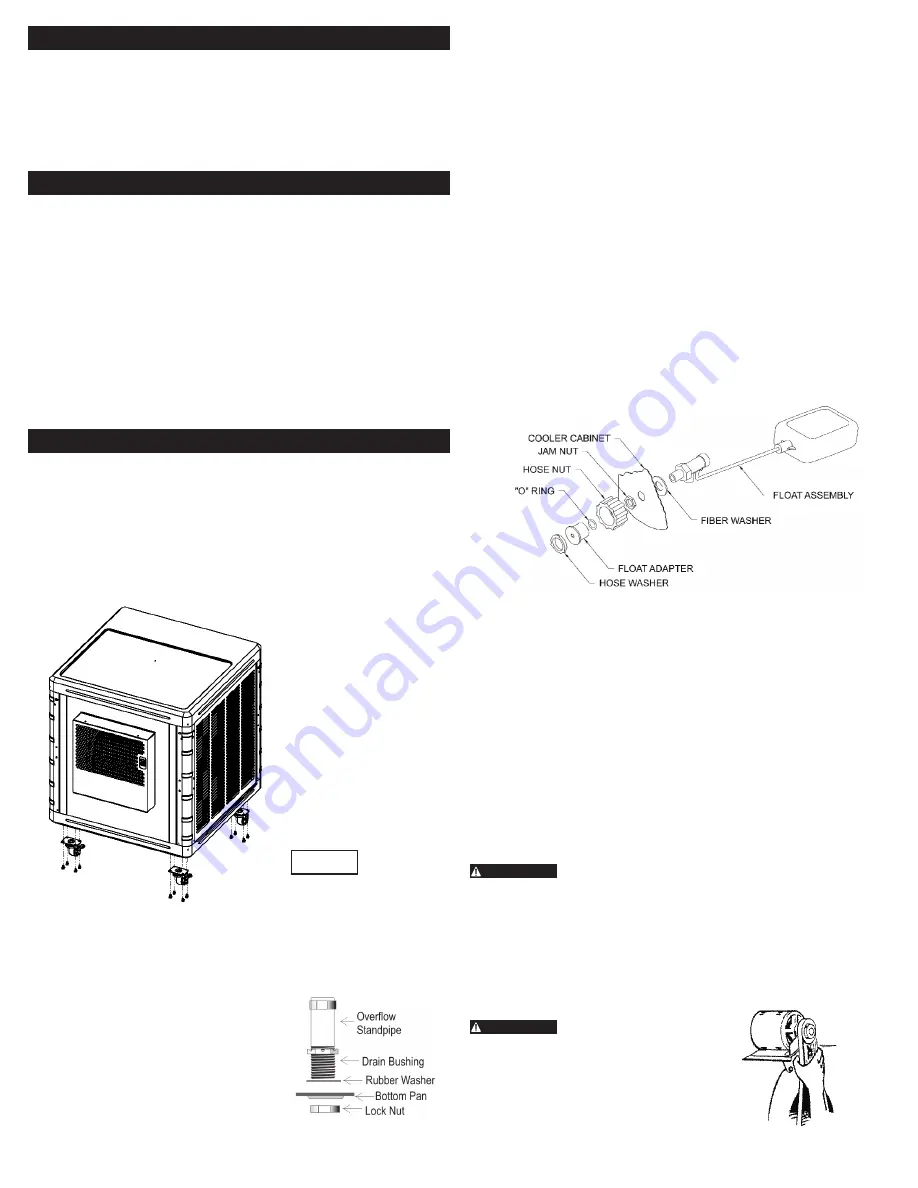
INTRODUCTION
Install float valve and hose adapter
Attach the float valve to the cabinet as shown below. The garden
hose adapter attaches to the brass inlet fitting on the float valve.
NOTE:
verify that the hose washers are correctly in place.
Water connection and float adjustment
Move cooler to desired location (this should be a level area for proper
operation of the cooler).
1. Locate a knock-out in the bottom of any of the four corner posts.
2. Connect to water supply using a commercial grade of water hose
(not supplied with cooler, obtained separately) to the adapter on
the float valve and turn water on. CAUTION: water inlet pressure
should be limited to a maximum of 65 PSI to avoid rupturing the
water hose. If pressure exceeds this value, an inline pressure
regulator should be installed (obtainable from a local plumbing or
hardware store).
3. Check that all connections are tight by visually inspecting hose,
float valve, etc. for leakage.
4. Set float valve for a water depth of 2-1/2". The float is adjusted by
lightly bending the float rod.
Your evaporative air cooler was thoroughly tested and inspected
before leaving the factory. This is your guide to economical, trouble
free comfort cooling over the years with reasonable care and regular
maintenance. Failure to follow these instructions may damage your
cooler, impair its operation and/or void the warranty
Read it carefully.
SET UP FOR ROLL-AROUND USE
• Open parts box & remove casters from parts bag. Assemble each
caster (Fig.1) per caster plate using supplied 1/4-20 nuts & carriage
bolts.
• Place casters w/ brakes on the front of the unit, and the casters
without the brakes should be mounted on the back of the cooler.
Use 4 of the 1/4-20 bolts from the parts bag to secure all 4 of the
casters to their respective caster plates. Apply brakes before lifting
cooler upright to complete assembly.
2 Master Blaster Use and Care Manual
PREPARATION FOR ASSEMBLY
Remove the pad frames by slightly lifting the pad frame from the
bottom, pull outwards until clear of cabinet bottom pan, then
downwards until frame clears cabinet top. Remove the following
items from the cooler:
1. Box containing swivel casters and attachment hardware.
2. Plastic bag containing small parts, float valve, garden hose adapter,
hose nut, hose washer, o-ring.
3. Bag with hose adapter for float valve (roll-around use)
Gather tools required to assemble & install unit
The following tools are required to assemble the unit:
7/16" box or open end wrench
3/8" box or open end wrench
6" crescent wrench
1/4" nut driver
Figure 1
Install Overflow Standpipe / Drain Line
Install overflow drain bushing in bottom of cooler as follows:
• Slide rubber washer over the brass drain
bushing.
• Push drain bushing through bottom of
cooler, assemble and tighten lock nut.
• Screw plastic overflow standpipe into the
drain bushing and tighten snugly (hand
tight) to prevent leakage.
• Where conditions allow for drainage,
connect a drain line (garden hose) to
drain bushing.
Cooler checkout and first time start-up
Congratulations, once you re-install the pad frames, your roll-around
Master Blaster cooler will be complete and ready for use. Please
proceed to the Pre-startup inspection checklist on page 3 before
starting unit for the first time.
Motor and blower wheel check
Check motor mounting to be sure all screws and nuts are tightened
down properly. Rotate blower wheel by hand to see that it moves
freely without rubbing against housing.
Belt Tension Adjustment
CAUTION:
Disconnect all electrical power to the cooler and insure that belt
is not rotating before adjusting belt tension.
Correct belt tension and alignment is important, proper setup reduces
power consumption and prolongs life of belt and motor. Check belt
tension by squeezing belt. Proper tension will allow deflection of ½
to ¾ inch. To increase or decrease belt tension, loosen bolt in slot of
motor support bracket. Adjust belt to proper tension and retighten
bolt.
CAUTION:
Never operate unit with pad frame(s)
and/or air outlet grille removed. This
will result in an overloaded condition
and may damage the motor.








